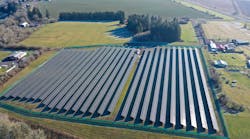Electricians and solar installers are required to navigate several codes and standards when installing solar photovoltaic (PV) and energy storage systems (ESSs). Solar and energy storage equipment manufacturers introduce new equipment at seemingly lightning speed; therefore it can be difficult to stay on top of all the requirements. This article highlights the key codes and requirements contractors working with solar PV and battery storage systems should be familiar with.
National Electrical Code
The most common code that system designers, installers, and inspectors refer to for PV and ESS installation is NFPA 70, National Electrical Code (NEC). PV systems have requirements that span multiple Articles in the NEC. Technicians need to navigate these requirements to install Code-compliant PV and ESS installations.
Article 690 [Solar Photovoltaic (PV) Systems] is the primary Article to reference when designing and installing PV systems. This Article supplements — and, in some cases, modifies — the general requirements located in Chapters 1 through 4 of the NEC. Article 690 has seen substantial changes over the last several Code cycles. These changes are not surprising given the rapidly advancing nature of the solar-plus-storage industry. Admittedly, the Code is often playing catch-up with advancements in solar technology and system components.
Everything in Art. 690 is important for technicians to understand, but here are a few of the key Sections that should be well understood and often lead to the most confusion.
Identification of PV system components in common configurations
There are five different images in Fig. 90.1(b) of the NEC, which was updated in the 2017 Code cycle. These images are important to examine because they visually help installers understand how to apply Code requirements to different solar PV components and circuits. For example, the Figure shown below — based on NEC Fig. 90.1(b) — shows a direct grid-tie system that does not incorporate storage. A direct grid-tie or “batteryless” PV system is the most common system type solar companies install across the country today. The image is helpful because it defines the PV system disconnect, a point of demarcation for the PV system.
The PV system disconnect does not necessarily need to be a knife switch. It can also be a breaker that interconnects the inverter to the electric utility supply. Additionally, it is important to note that this image may not represent all required system components.
Section 690.12
Rapid shutdown requirements were added to the NEC during the 2014 Code cycle. The intention of rapid shutdown is to protect firefighters from the shock hazards they may encounter when interacting with a rooftop PV array while doing fire-suppression activities. When installed to Code with good attention to installation details, solar PV systems are inherently as safe as any other electrical system installed per Code. Note that these rapid shutdown systems are not meant to be used during routine system-maintenance activities.
Rooftop solar PV array circuits must be controlled to reduce potential shock hazards to firefighters. To meet this requirement, the rapid shutdown section of the NEC provides multiple ways to meet the requirements based on the location of the circuit in relation to the PV array.
Many PV installers use module-level power electronics (MLPE) to meet these rapid shutdown requirements. MLPE devices are typically mounted directly to the same racking system that supports the PV modules and are wired directly to the modules. These devices may be DC-to-DC converters or DC-to-AC inverters. MLPE can control the voltage on their respective circuits through a rapid shutdown initiation. The most common initiation is the loss of AC power that sends a signal to the MLPE devices to reduce the circuit voltage to an acceptable level per Code requirements. Other initiation devices that are properly labeled and accessible are acceptable as well.
A recently released UL standard, “UL 3741 Photovoltaic Hazard Control,” is being employed by some manufacturers. This standard provides testing mechanisms for equipment manufacturers to prove their equipment provides effective and compliant shock protection for firefighters. This new standard and its application on the rooftop lead to new array configurations, inverter location strategies, and reducing (or possibly eliminating) the need for MLPE devices within the array while still meeting Sec. 690.12 requirements.
Article 705 [Interconnected Electric Power Production Sources]
This Article covers the requirements for interconnecting all power production sources, so it isn’t unique to solar. Most installed PV systems are interconnected with the electric utility grid; therefore, Art. 705 is an integral part of installations.
The most often-cited section of Art. 705 are Sec. 705.11 [Supply-Side Source Connections] and Sec. 705.12 [Load-Side Source Connections]. The reference to “side” is the main service-disconnecting means. Article 705 allows for the connection of power-production sources to either side of the main service-disconnecting means. This is an important consideration, as the associated requirements can be dramatically different depending on where the connection is located in relation to the main service disconnect.
Additional Articles that impact PV installations include: Art. 691 [Large-Scale Photovoltaic (PV) Electric Supply Stations]; Art. 706 [Energy Storage Systems]; Art. 480 [Storage Batteries]; and the entirety of Chapters 1 through 4 — with Art. 250 and Art. 300 being commonly referenced.
The addition of battery storage to existing or new PV systems is growing rapidly across the U.S. In many cases, jurisdictions do not have much, if any, experience with these systems. Authorities Having Jurisdiction (AHJs) often rely on solar-plus-storage system installers for help understanding the proper Code requirements that apply to a given system. This information-sharing partnership is similar to general PV systems 20 years ago, when the learning curve for Code officials was also steep. It is important for installers to recognize the codes and standards that apply to solar and energy storage systems. Be prepared to help educate your local code officials, especially in regions where solar PV is less common or when manufacturers release new equipment and technologies.
Fire codes
Outside of the NEC, technicians need to be cognizant of the fire codes their jurisdictions enforce and how PV systems are regulated within those codes. The most common fire codes are NFPA 1, Fire Code and ICC’s International Fire Code (IFC). These codes typically impact the physical layout of PV modules on the roof of a building. The intent is to provide safe access around the equipment in the case of a first responder suppressing a structure fire from a building’s rooftop.
The rules typically vary based on the type of structure — residential versus commercial, the roof pitch, and the overall area of the array. Pathways around the perimeter of the array are a general requirement per IFC 605.11.3.2.1. Residential requirements start with 3-ft pathways for firefighter access. For larger commercial rooftops, it is common to require pathways across the roof at least every 150 ft.
Fire codes also regulate the use and location of ESSs. Chapter 15 of NFPA 855, Standard for the Installation of Stationary Energy Storage Systems, provides requirements for residential systems. ESS spacing, unit capacity limitations, and maximum allowable quantities (MAQ) depending on location.
Structural codes
PV systems also have structural requirements and codes associated with them. Many jurisdictions use ICC’s International Building Code (IBC) and ASCE 7 to guide the structural components of a PV installation. The IBC addresses the installation methods of roof attachments in Sec. 1503, fire classifications for PV systems in relation to the roofing material in Sec. 1509, and structural loading considerations in Sec. 3403. This aspect of PV installations can vary widely between jurisdictions, so it is best to familiarize yourself with the local requirements prior to system design and installation.
Ryan Mayfield is the CEO and founder of Mayfield Renewables, Corvallis, Ore., a technical consultancy and system design and engineering firm well known for solar-plus-storage expertise. He has more than 20 years of experience designing and consulting on solar PV projects while also teaching NABCEP-certified courses on the NEC. He can be reached at [email protected].





